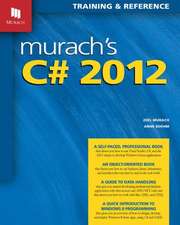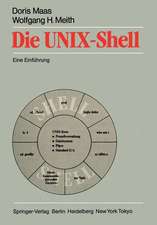Software Performability: From Concepts to Applications: The Springer International Series in Engineering and Computer Science, cartea 347
Autor Ann T. Tai, John F. Meyer, Algirdas Avizienisen Limba Engleză Hardback – 31 dec 1995
Software Performability: From Concepts to Applications addresses the construction and solution of analytic performability models for critical-application software. The book includes a review of general performability concepts along with notions which are peculiar to software performability. Since fault tolerance is widely recognized as a viable means for improving the dependability of computer system (beyond what can be achieved by fault prevention), the examples considered are fault-tolerant software systems that incorporate particular methods of design diversity and fault recovery.
Software Performability: From Concepts to Applications will be of direct benefit to both practitioners and researchers in the area of performance and dependability evaluation, fault-tolerant computing, and dependable systems for critical applications. For practitioners, it supplies a basis for defining combined performance-dependability criteria (in the form of objective functions) that can be used to enhance the performability (performance/dependability) of existing software designs. For those with research interests in model-based evaluation, the book provides an analytic framework and a variety of performability modeling examples in an application context of recognized importance. The material contained in this book will both stimulate future research on related topics and, for teaching purposes, serve as a reference text in courses on computer system evaluation, fault-tolerant computing, and dependable high-performancecomputer systems.
| Toate formatele și edițiile | Preț | Express |
|---|---|---|
| Paperback (1) | 983.20 lei 6-8 săpt. | |
| Springer Us – 27 sep 2011 | 983.20 lei 6-8 săpt. | |
| Hardback (1) | 988.16 lei 6-8 săpt. | |
| Springer Us – 31 dec 1995 | 988.16 lei 6-8 săpt. |
Din seria The Springer International Series in Engineering and Computer Science
- 24%
 Preț: 1041.98 lei
Preț: 1041.98 lei - 20%
 Preț: 643.50 lei
Preț: 643.50 lei - 18%
 Preț: 1225.62 lei
Preț: 1225.62 lei - 18%
 Preț: 965.02 lei
Preț: 965.02 lei - 20%
 Preț: 646.12 lei
Preț: 646.12 lei - 18%
 Preț: 948.79 lei
Preț: 948.79 lei - 20%
 Preț: 646.62 lei
Preț: 646.62 lei - 15%
 Preț: 637.46 lei
Preț: 637.46 lei - 20%
 Preț: 643.83 lei
Preț: 643.83 lei - 18%
 Preț: 949.23 lei
Preț: 949.23 lei - 20%
 Preț: 644.48 lei
Preț: 644.48 lei - 20%
 Preț: 994.92 lei
Preț: 994.92 lei - 20%
 Preț: 645.97 lei
Preț: 645.97 lei - 18%
 Preț: 946.87 lei
Preț: 946.87 lei - 20%
 Preț: 995.57 lei
Preț: 995.57 lei - 18%
 Preț: 956.99 lei
Preț: 956.99 lei - 20%
 Preț: 644.98 lei
Preț: 644.98 lei - 15%
 Preț: 649.54 lei
Preț: 649.54 lei - 18%
 Preț: 950.21 lei
Preț: 950.21 lei - 18%
 Preț: 1221.38 lei
Preț: 1221.38 lei - 18%
 Preț: 957.62 lei
Preț: 957.62 lei - 15%
 Preț: 643.99 lei
Preț: 643.99 lei - 18%
 Preț: 948.47 lei
Preț: 948.47 lei - 18%
 Preț: 947.35 lei
Preț: 947.35 lei - 20%
 Preț: 1284.65 lei
Preț: 1284.65 lei - 20%
 Preț: 1628.31 lei
Preț: 1628.31 lei - 20%
 Preț: 1285.78 lei
Preț: 1285.78 lei
Preț: 988.16 lei
Preț vechi: 1235.19 lei
-20% Nou
Puncte Express: 1482
Preț estimativ în valută:
189.09€ • 202.20$ • 157.65£
189.09€ • 202.20$ • 157.65£
Carte tipărită la comandă
Livrare economică 18 aprilie-02 mai
Preluare comenzi: 021 569.72.76
Specificații
ISBN-13: 9780792396703
ISBN-10: 0792396707
Pagini: 202
Ilustrații: XIV, 202 p.
Dimensiuni: 156 x 234 x 18 mm
Greutate: 0.45 kg
Ediția:1996
Editura: Springer Us
Colecția Springer
Seria The Springer International Series in Engineering and Computer Science
Locul publicării:New York, NY, United States
ISBN-10: 0792396707
Pagini: 202
Ilustrații: XIV, 202 p.
Dimensiuni: 156 x 234 x 18 mm
Greutate: 0.45 kg
Ediția:1996
Editura: Springer Us
Colecția Springer
Seria The Springer International Series in Engineering and Computer Science
Locul publicării:New York, NY, United States
Public țintă
ResearchCuprins
1 Introduction.- 1.1 Need for Unified Measures.- 1.2 Basic Definitions and Associated Terminology.- 1.3 Overview of Chapters.- 2 General Concepts and Applications of Performability Modeling.- 2.1 Concepts.- 2.2 Developments and Applications.- 3 Framework of Software Performability Modeling.- 3.1 Overview.- 3.2 Formal Framework.- 4 Viable Techniques for Model Construction and Solution.- 4.1 Introduction.- 4.2 Modeling Techniques.- 4.3 Using Different Modeling Techniques: Examples.- 5 Case Study I: Comparative Studies of Fault-Tolerant Software.- 5.1 Introduction.- 5.2 General Approach.- 5.3 RB Model.- 5.4 Basic NVP Model.- 5.5 Comparative Evaluation Results.- 5.6 Improving Effectiveness.- 5.7 Conclusion.- 6 Case Study II: Performability-Management Oriented Adaptive Fault Tolerance.- 6.1 Introduction.- 6.2 An Adaptive Fault-Tolerant System.- 6.3 Performability Variable.- 6.4 Base Model Construction and Solution.- 6.5 Adaptive Rule Generation.- 6.6 Analysis.- 6.7 Discussion.- 7 Case Study III: Performability Management in Distributed Database Systems.- 7.1 Introduction.- 7.2 Background.- 7.3 Performability Models.- 7.4 Evaluation and Discussion.- 7.5 Summary and Future Work.- References.- A San Specifications.- A.1 SAN Model for Synchronized Checkpointing.- A.2 SAN Model for Asynchronous Checkpointing.- B Sample Mathematica Programs and Outputs.- B.1 Mathematica Program for Performability Evaluation of RB.- B.2 Mathematica Output for Performability Evaluation of RB.- B.3 Mathematica Program for Performability Evaluation of Basic NVP.- B.4 Mathematica Output for Performability Evaluation of Basic NVP.- B.5 Mathematica Program for Performability Evaluation of NVP-TB.- B.6 Mathematica Output for Performability Evaluation of NVP-TB.




















